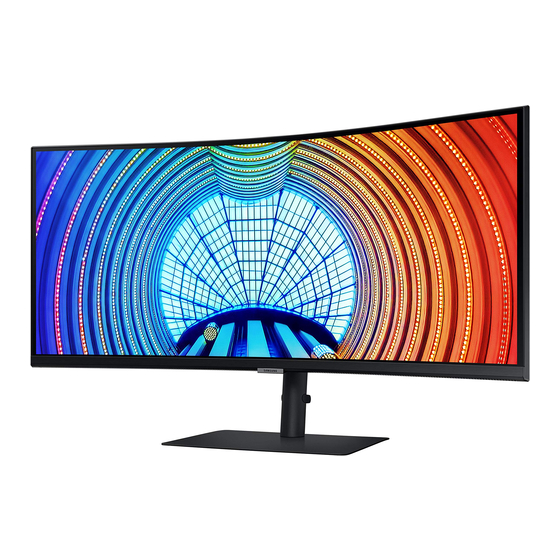
Table of Contents
Advertisement
User Manual
S34A65*
The color and the appearance may differ depending on the product, and the specifications are subject to
change without prior notice to improve the performance.
The contents of this manual are subject to change without notice to improve quality.
© Samsung
Samsung owns the copyright for this manual.
Use or reproduction of this manual in parts or entirety without the authorization of Samsung is
prohibited.
Trademarks other than that of Samsung are owned by their respective owners.
Advertisement
Table of Contents

Summarization of Contents
Product Usage Guidance
Safety Precautions
Essential warnings and precautions for safe operation.
Electricity and Safety
Guidelines for safe electrical connections and usage.
Product Installation
Steps and considerations for setting up the product.
Product Operation
Instructions for basic product usage and handling.
Product Cleaning
Procedures for maintaining and cleaning the product.
Ergonomic Usage Posture
Recommendations for ergonomic setup and usage.
Product Setup and Preparations
Stand Assembly
Detailed steps for assembling the product stand.
Moving and Space Planning
Guidelines for safe moving and required clearance.
Tilt and Height Adjustment
How to adjust the monitor's position.
Anti-theft Lock
Information on securing the product with a lock.
VESA Mount Specifications
Details for mounting the monitor using VESA standards.
Control Panel Overview
Explanation of the monitor's control buttons and functions.
Direct Key Guide
Shortcuts for accessing functions directly.
Source Device Connectivity
Connection Preparation Steps
Important steps before connecting external devices.
Port Identification
Overview of all input and output ports on the monitor.
PC Connection Methods
Methods for connecting a PC via various cables.
Audio, Power, and USB Hub
Connecting audio, power, and using the monitor as a USB hub.
Cable Management
Tips for organizing connected cables.
Optimum Resolution Setup
Setting the best display resolution for performance.
HDR10 Graphics Card Support
List of graphics cards compatible with HDR10.
Monitor Menu and Settings
Picture Mode Settings
Adjusting picture quality for different viewing environments.
Brightness, Contrast, Sharpness
Fine-tuning basic picture elements.
Color, Black Level, Response Time
Adjusting color, black levels, and panel response.
Game Mode, Screen Ratio, Adjustment
Optimizing for gaming, aspect ratio, and position.
Eye Care and PIP/PBP
Features for eye comfort and multi-screen display.
OnScreen Display Configuration
Customizing the OSD menu appearance and behavior.
System and Power Management
Configuring general system, FreeSync, and power saving.
Input and USB-C Preferences
Managing input modes and USB-C functionality.
Product Support
Self Diagnosis
Running a built-in test for monitor issues.
Software Update Procedure
Steps to update the monitor's firmware via USB.
Information and Reset Options
Viewing software info and restoring factory settings.
Software and Driver Installation
Easy Setting Box Usage
Utilizing software for screen partitioning.
Installation Restrictions
Factors affecting software installation success.
System Requirements
Hardware and OS prerequisites for software.
Driver Installation Guide
Installing necessary drivers for optimal performance.
Troubleshooting Common Issues
Pre-Contact Service Guidelines
Steps to take before contacting customer support.
Initial Product Diagnosis
Using self-diagnosis for screen issues.
Resolution and Frequency Checks
Verifying display settings for compatibility.
Installation Issues
Problems related to connecting the monitor.
Screen Display Problems
Addressing distorted, blurry, or unstable images.
Sound and Source Issues
Resolving audio problems and source device detection.
Common Settings Q&A
Answers to frequent questions about settings.
Product Specifications
General Product Information
Key details like model, size, and power.
Connectivity and Environmental Specs
Ports, operating, and storage conditions.
Plug-and-Play and Pixel Info
Compatibility features and pixel characteristics.
Standard Signal Mode Table
Supported resolutions, frequencies, and timings.
FreeSync Feature Details
FreeSync Overview
Explanation of tear-free gaming technology.
Enabling and Disabling FreeSync
How to turn the feature on or off.
Potential Issues and Solutions
Common problems and troubleshooting steps.
Supported Graphics Cards
List of AMD cards compatible with FreeSync.












Need help?
Do you have a question about the LS34A650UXNXGO and is the answer not in the manual?
Questions and answers